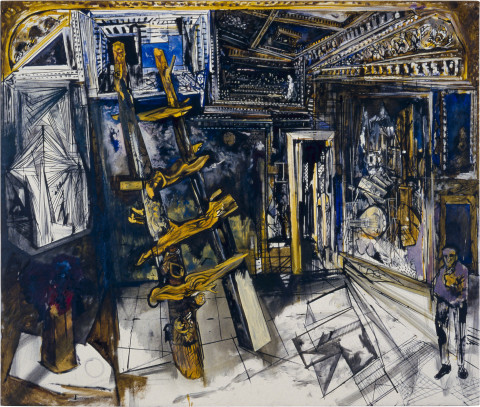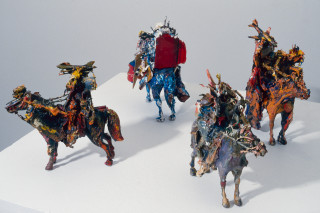We arrive at the Victor Rubin universe by boat. The Ships at Sea are like Night and Day, Life and Death, Eros and Thanatos. For all of us, these are the two travels we endlessly make. We go to sea on the sieve of our bodies — and on these boats, if you look carefully, are fragments (livers, lungs, galls, kidneys) of plastic model bodies.
Exhibition Dates: 8 April – 25 April 1987
Great Frozen Pizzas! Flaming Wastepaperbaskets! Typhoons of Wind-Driven Saliva! Who is this Geronimo in full-dress war-paint? Yes it's Victor Rubin, proto-punk shaman of the Universal Garbage Apocalypse. Gothic Futurist in a world of planned and bomb-wrought demolition. Groucho Marxist of the Finance Field Wars.
Seldom has a painter achieved work further removed from Minimalist protocol than the work of Victor Rubin. That is from our current phlegmatic apathy, our spill proof, dry-lipped, mind-munching Post Modernism: an "ism" that stands perhaps for more than it achieves. Not for him the gentlemanly political gambit or the level-as-a-desk-top NeoGeo cool. For a decade and a half he's left that to the other arts coachparties that have come and gone with their anorexia, Zero Population Growth, and cloning. One-of-a-kind Victor Rubin runs on energy, not good advice — energy that responds to a history that puts us through the shredder, history of the sudden, the disruptive, the violent, the random and the unaccounted-for kind. For strains out of phase with each other the 36 year-old painter has developed techniques as busy, quick and concentrated as Thomas Pynchon played on electric guitar. Highly evolved forms of disintegration require riffs and rhythms that have the accelerated velocity of scrap recycling. Here Iggy Pop's Zombie Birdhouse Blah Blah Blah meets Salvador Dali's Premonition of Civil War or soft Construction of Boiled Beans.
In the words of Stanley Elkin: "We're in the homestretch of the race: your energy against my entropy. The universe is running down, Mr. Developer. It's bucking and filling. It's yawing and pitching and rolling and falling. The smart money's in vaults."
In earlier works Rubin has depicted this universe with cover-the-earth energy: massive elliptical epics about colliding tribes assaulted by Gotterdammerung weather. Helicopters wheel like rooks in landscapes full of writhing mustard-coloured rocks. A picnic of punk poets daydream a Wild West by George Grosz. Mile-long Dime Novel Dioramas stagemanaged by Max Ernst. The new work has more control, is more focused. Moving away from the domineering scale and Flea Market congestions allow his concerns to be more complex than the big picture morality of Daily News headlines. More than mere showmanship his skill of the involuntary has become more pointed and personal, more poetic and persuasive.
We arrive at the Victor Rubin universe by boat. The Ships at Sea are like Night and Day, Life and Death, Eros and Thanatos. For all of us, these are the two travels we endlessly make. We go to sea on the sieve of our bodies — and on these boats, if you look carefully, are fragments (livers, lungs, galls, kidneys) of plastic model bodies. On the Dark Boat — The Iron Lung — a shoe sole, a safety pin tarred with red paint, a champagne cork wire for the crow's nest. On the Light Boat — The Don Juan — combines computer wires and light-sockets with Indian, Fireman and Buddha. Are we pirates? slaves? refugees? fools?
The Four Horsemen of the Apocalypse, all plastic and PVC, advance like hanging judges. Colourful shrouds of power, passing through eons and empires, through hailstorms of supermarket dreck, eating up space like a plague of dirty dishes. They are like the Marx Brothers singing "All God's chilluns got guns". And we're reminded that a real tank is a projection of a toy tank, made small enough for a child's hand and imagination to grasp.
In the paintings punched card skylines provide settings for soldiers to strew grenades of paint like fertilizer, or fire machine-guns of Berger Spray across a rattattat of recent history — whether it be Berlin, Belfast or Beirut. Images are created out of Air Fix Model Kit stencils and so between streetless rows of transistorised buildings, paint rusts like old cars, paint catches fire, whole towns built around a crust of squashed acrylic do too. Edges of refugee settlements struggle under scarred pavements shadowed by Chrome, White and Matt Black faces fill with fish oil, eyes vomit perception, and meaning escapes or rots in gestalt-splotches or wood-grain. Victor Rubin bursts the seams with inventions because he lives through his body the way most of us get through the day.
Increasingly at the centre of his symbols, Rubin has made a series of AutoMasks that define the artists as Priest, Alchemist, lonely lodger in a a Rococo asylum. Strange eyes in strange spaces in stranger minds. Rooms recede like illustrations in perspective manuals. Pillars, columns and corridors perform trompe l'oeil tricks — perception goes backwards. Mouldings that separate walls into panels lose their stiffness to become frames garlanded with flowers or terrminatein elaborate scrolls or stencilwork. Chairs, mirrors, picture-frames, & cornices over doorways dissolve before one's eyes into a necropolitan menagerie under candleflicker. Pediments blow up into a rash of plasterwork soldiers, locusts, helicopters, blowflies — the whole lava and lingere of paint.
Painting is Victor Rubin's fuel, flue and fireplace. Performed as ritual by a debt-redeeming wizard, Rubin populates his dreams like a child studying moss, digging out the biblical crannies tiny obstinate weeds with wall-paper scrapers, with steak-knife edge sliding paint like meat of its bones. His brush is his honeyspoon, fingers in jelly, his liquorice stick. I don't know anybody else for whom the activity of painting is the completest expression of wish, need, desire; nobody whose years of training has not inhibited the sources of creativity, indeed, who is so close to art starting over in its vivid infancy, inside its seed. Take this sundrunk reminscence that proves that painting is his swaddle, his Sunday, his Seventh Heaven and Sleep.
"I must have been around three when I discovered the magic of drawing with water on concrete. It was incredibly exciting making all those marvellous shapes, but so frustrating watching them disappear before my eyes as the water evaporated in the sun. My normally tolerant mother put a sudden stop to my afternoons activities when I began picking off branches from our frangipani tree and drawing with the sticky white sap."
George Alexander
29.03.87


























